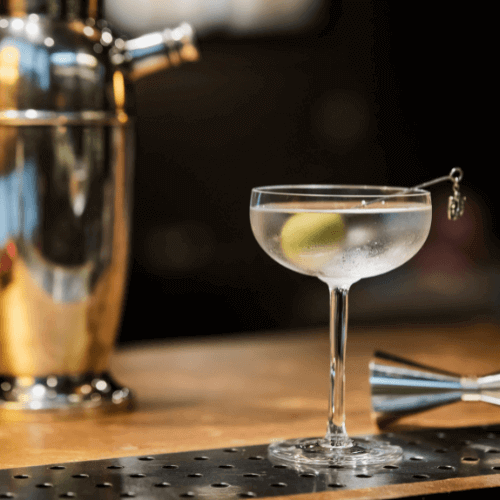Table of Contents The Bahama Mama cocktail often served in a hurricane glass with a colorful umbrella, is a delightful...
Published: 01/04/24

The martini, a cocktail known for its simplicity, sophistication, and versatility, has become an iconic symbol of the cocktail culture. This timeless cocktail, traditionally made with gin and vermouth and adorned with an olive or a lemon twist, has undergone a fascinating evolution over the years. Referred to as the “classic martini” its popularity has transcended eras and continents, solidifying its place as one of the most recognized mixed alcoholic beverages globally.
The exact birthplace of the martini remains shrouded in mystery. One theory proposes that the name “martini” may have been inspired by the Martini & Rossi vermouth brand, a key ingredient in the cocktail. However, an equally compelling narrative suggests that the martini evolved from the Martinez cocktail, served in the early 1860s at the Occidental Hotel in San Francisco, crafted by Bartender Jerry Thomas. This theory asserts that patrons frequented the Occidental Hotel before embarking on an evening ferry to Martinez, California. The first mention of the Martinez Cocktail appeared in the 1884 book “The Modern Bartenders’ Guide” by O.H. Byron, adding a layer of historical intrigue to the cocktail’s origin.
Adding to the mystique surrounding the martini’s origin, Martinez residents proudly claim their city as the birthplace of this iconic cocktail. According to local tales, a skilled bartender in Martinez, California, crafted the first martini, weaving a unique narrative into the drink’s history. This alternate perspective adds a touch of community ownership to the cocktail’s legacy, portraying the martini not just as a global icon but as a drink rooted in the history and stories of a specific place.
A dry martini is characterized by a diminished sweetness, achieved through a reduced amount of dry vermouth. The cocktail’s dryness is accentuated by the subtle interplay between the gin and the dry vermouth, creating a balance that caters to those who appreciate a more restrained sweetness in their cocktails. This nuanced distinction in the martini’s composition reflects the intricacies of mixology, where slight adjustments in ingredient ratios transform a classic cocktail into a personalized experience.
By 1922, the martini had assumed its most familiar version, featuring a blend of London dry gin and dry vermouth in a 2:1 ratio. The traditional method for crafting this classic recipe includes mixing the ingredients with ice in a mixing glass. There’s also the choice of adding optional orange or aromatic bitters. Afterward, the mixture is strained into a chilled cocktail glass. The decision on garnish, whether it’s a green olive or a twist of lemon peel, is left to the drinker’s personal preference.
As the cocktail culture evolved, so did the martini’s recipe. The 1930s witnessed a shift towards a drier martini, with a gin-to-vermouth ratio of 3:1. The subsequent decade saw a further reduction in vermouth, with a 4:1 ratio becoming the norm during the 1940s. The latter part of the 20th century brought about even drier variations, with 5:1 or 6:1 dry martinis gaining popularity. For those seeking an extra dry experience, ratios could extend to 8:1 or even 15:1.
The martini has transcended its status as a mere cocktail to become a cinematic icon, gracing the silver screen with timeless elegance and sophistication. Throughout film history, the martini has been a symbol of refinement, often associated with debonair characters and high-stakes situations. From the suave James Bond ordering his signature “shaken, not stirred” martini to the mysterious and alluring characters of film noir swirling the drink in dimly lit bars, the martini has become a visual shorthand for sophistication and coolness.
Classic Hollywood films frequently used the martini to convey a character’s social standing and taste. The act of ordering or crafting a martini became a cinematic ritual, emphasizing the attention to detail and the artistry of mixology. The clinking of ice in a shaker and the strained pour into a perfectly chilled glass added a sensory dimension to the on-screen experience, immersing audiences in the world of glamour and allure. In contemporary cinema, the martini continues to make appearances, both as a nod to the classics and as a symbol of enduring style.
75 ml gin
15 ml dry vermouth
Ice
Garnish: olive or lemon twist

Add the gin and dry vermouth into a mixing glass.
Add ice and stir for 10-15 seconds, until chilled.
Strain into a martini glass.
Garnish with an olive or lemon twist.
Our Team
Hi, we’re mixdrinkipedia team. Welcome to our cocktail corner of the web, crafted by our dedicated team, passionate about everything that makes mixology magical. We’re a group of enthusiasts and professionals, blending our diverse skills and backgrounds to create a space where the art of cocktails is celebrated from intricate recipes and deep dives into the history of cocktails to reviews on the latest in bar tools. Join us as we explore the art and science of mixology, one sip at a time.
Newest Recipes
Table of Contents The Bahama Mama cocktail often served in a hurricane glass with a colorful umbrella, is a delightful...
Table of Contents The Trinidad Sour cocktail is a combination of Angostura bitters, lemon juice, orgeat syrup, and rye whiskey...
Table of Contents The snifter glass is a type of glassware that is used to serve Bradney, bourbon, strong beer,...
Facebook Print Email WhatsApp Published: 02/18/24 Table of Contents The Vesper cocktail, also recognized as the Vesper martini, epitomizes a...
MixDrinkiPedia.com is a participant in the Amazon.com Services LLC Associates Program. As an Amazon Associate we earn from qualifying purchases. Amazon and the Amazon logo are trademarks of Amazon.com, Inc. or its affiliates.